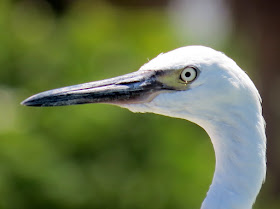Great Egret x Snowy Egret hybrid, Fort de Soto Park, Pinellas County (Florida, USA), 18th August 2016 - copyright Dave Norgate
(photo ID: 2987)
Dave says this bird seemed intermediate in size between Great Egret and Snowy Egret. Structurally it seems to have an intermediate neck length and shape - you can see a hint of the kinked shape of Great Egret in some of the photos but it's not as clear as in a pure bird. The bare parts also seem to be consistent with expectations for this hybrid. Certainly the legs are wrong for Snowy Egret being entirely black right down to the bottom of the feet. The gape line only extends back to below the cetnre of the eye, just like it does on Snowy Egret. On Great Egret it would extend right back to beyond the back of the eye. The only pure species I could possibly turn this into is Intermediate Egret, which in some respects it quite closely resembles. However, although the Asian form of Intermediate Egret apparently does adopt a black bill in breeding condition (I don't believe the African form does) this bird is showing no sign of being in breeding condition. I don't think the bill structure is quite right for Intermediate Egret either, and of course an Asian Intermediate Egret is rather unlikely in Florida - there are one or two ABA-area records but only from the Aleutian Islands in western Alaska so far as I know.
Great Egret x Snowy Egret hybrid (same bird as in photo ID 2987 above), Fort de Soto Park, Pinellas County (Florida, USA), 18th August 2016 - copyright Dave Norgate
(photo IDs: 2988-2991)
Great Egret Ardea alba
Snowy Egret Egretta thula






This is a juvenile Reddish Egret (Egretta rufescens) white morph. They can and frequently show yellow lores like the individual photographed here. Nothing seems to indicate any other species' input. Here are some nearly exact matches from Macaulay Library: https://macaulaylibrary.org/asset/240850691 , https://macaulaylibrary.org/asset/31053991 , https://macaulaylibrary.org/asset/63822091 Many more can be found with a quick serch
ReplyDeleteDefinitely Reddish Egret, as mentioned ~ When you’re not sure (or anytime, really), upload the photo and location to iNaturalist (by National Geographic), and community members can add IDs (you can add your own ID, too). At some point a Community Taxon is reached, and the data is available to scientists and the public alike. The Florida Fish and Wildlife Conservative Commission is active on iNat, too, which is a great benefit to our state. By the way, great photos, Dave! You really captured it well.
ReplyDeleteForgot to mention — since you’re a photographer, you may be interested to know that you can set your iNat settings so all rights are reserved on your photos, if desired.
ReplyDelete